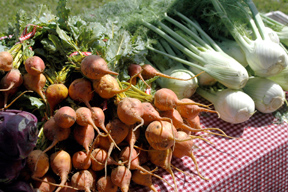
Most farmers say summer farmers’ market is struggling
For more than a decade, farmers in San Benito County have been
offering local customers fresh produce at the summer farmers’
market in Downtown Hollister. But even after years of selling, the
number of people who support the farmers’ market has only grown
marginally.
Organizers of the market have changes planned before the
Most farmers say summer farmers’ market is struggling
For more than a decade, farmers in San Benito County have been offering local customers fresh produce at the summer farmers’ market in Downtown Hollister. But even after years of selling, the number of people who support the farmers’ market has only grown marginally.
Organizers of the market have changes planned before the launch of the 2007 market in hopes of drawing in more people.
This year, organizers are extending the period when the market will operate. It will start two weeks earlier, in mid-May and continue through the month of September, so growers can offer customers a quality selection of fall vegetables as well, said Sharlene Van Rooy, the manager of the Hollister farmers’ market.
Additionally, some major media exposure about the benefits of eating locally produced fruits and vegetables seems to be registering with the public.
Becky Herbert, owner of Eating with the Seasons – a San Benito County-based Community Supported Agriculture program – said she has seen a tremendous increase in the number of people purchasing produce from their business since Time magazine published an article on the benefits of eating locally versus eating organically grown foods, published in March.
Still, just because a major national magazine ran a cover story touting the benefits of eating locally, that does not mean people in San Benito County will be swayed.
“The biggest problem is getting people out [to the farmers’ market],” said Dick Swank, owner of Swank Farms. “You need people in order to have a successful summer market. It seems as though the demand for fresh stuff is not as important to some people. Families don’t have time to go to the market, so they buy whatever is available.”
When the farmers’ market isn’t busy, it hurts the farmers, because most of the time they aren’t making a tremendous amount of money from the markets, even though they provide the opportunity for people to buy fresh fruits and vegetables, Swank said.
Paul Hain, an organic chicken rancher, orchardist and member of the Farmers Market committee, agreed.
“Farmers need to support the market, but it’s not a big money maker,” Hain said. “If more people supported the market, it would be easier for farmers to participate. That takes the support of residents.”
Part of the reason more people might not attend the farmers’ markets might be because it’s on a weeknight, but Van Rooy explained Wednesday night was the only available time farmers could agree to, since many also participate in other larger farmers markets out of the county on other days.
Many cities have farmers markets on Saturday mornings.
“Most vendors do eight-plus farmers’ markets per week, so a Saturday was not an option,” Van Rooy said.
Hain agreed.
“There are stronger markets in other towns on Saturdays,” Hain said. “The farmers need to support the local farmers market, but it isn’t a big money maker. In another market I can sell twice as much in half the time. If more people supported the market it would be easier.”
Hain seemed unsure if the number of attendees can be increased.
“If in San Benito County we have 60,000 people, there is only a certain percentage of those people that are going to shop at the farmers market,” Hain said. “Likewise, if San Francisco County has 1 million people and you take the same percentage as in San Benito County, the number of people that are going to go to a farmers market in that county is much larger than here.”
One of the ways that Van Rooy is hoping the market will attract more customers is through increased advertising. The farmers market is sending flyers to schools and daycare providers so that parents receive the information.
There is also a database of people that went to last year’s farmers market who will receive mailers from market organizers.
Some people are anxious to see more year-round options for buying year-round locally grown produce.
“I go every week. It just makes more sense to know where your food comes from,” said Steve Jeffries, a Hollister resident. “What I’d like to see is something more permanent. Not just during the summer.”
Unfortunately for Jeffries a year-round farmers’ market would first require a successful summer market, something that has yet to happen.
“The time is not right for a year-round market,” Van Rooy said.
Swank agreed.
“It would definitely take a successful summer market first,” Swank said. “The markets really drop off in the wintertime, so it would also take a big base of customers. Ours is small. It seems like when school starts the numbers really drop off.”
A year-round market could succeed in San Benito County if it was done properly and emphasized the location as a hub for tourism, according to Joseph McIntyre, executive director for the Ag Innovations Network.
A location that sold predominantly foods and wines from San Benito County could be a good thing for local agriculture, McIntyre said.
“It wouldn’t make sense to believe that the residents could support it alone,” McIntyre said. “But if it were a factor in tourism, it could work. But the whole reason to be doing this has to be about helping growers. One of the benefits of a market like that could be that it provides an opportunity to make a connection between local growers and area restaurants so there is more emphasis on Buy Local First.”









